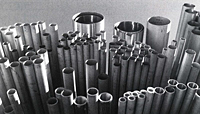| Items |

6061-T6P-500-109
Structural Aluminum Pipe - Series 6061-T6
|

6061-T6P-750-113
Structural Aluminum Pipe - Series 6061-T6
|

6061-T6P-1000-133
Structural Aluminum Pipe - Series 6061-T6
|

6061-T6P-1250-140
Structural Aluminum Pipe - Series 6061-T6
|

6061-T6P-1500-145
Structural Aluminum Pipe - Series 6061-T6
|
|
Material
|
N/A
Aluminum
|
|
Shapeform
|
N/A
Pipe
|
|
Series
|
N/A
6061-T6
|
|
Grade
|
N/A
6061
|
|
Temper
|
N/A
T6
|
|
Standard
|
N/A
Schedule 40
|
|
Nominal Size
|
N/A
1/2 inches
|
N/A
3/4 inches
|
N/A
1 inches
|
N/A
1 1/4 inches
|
N/A
1 1/2 inches
|
|
Nominal Size
|
N/A
0.5 inches12.7 mm
|
N/A
0.75 inches19.05 mm
|
N/A
1 inches25.4 mm
|
N/A
1.25 inches31.75 mm
|
N/A
1.5 inches38.1 mm
|
|
O.D.
|
N/A
0.84 inches21.336 mm
|
N/A
1.05 inches26.67 mm
|
N/A
1.315 inches33.401 mm
|
N/A
1.66 inches42.164 mm
|
N/A
1.9 inches48.26 mm
|
|
I.D.
|
N/A
0.622 inches15.7988 mm
|
N/A
0.824 inches20.9296 mm
|
N/A
1.049 inches26.6446 mm
|
N/A
1.380 inches35.052 mm
|
N/A
1.610 inches40.894 mm
|
|
Wall Thickness
|
N/A
0.109 inches2.7686 mm
|
N/A
0.113 inches2.8702 mm
|
N/A
0.133 inches3.3782 mm
|
N/A
0.140 inches3.556 mm
|
N/A
0.145 inches3.683 mm
|
|
Weight
|
N/A
0.2944 lbs/ft0.4381154816 kg/m
|
N/A
0.3912 lbs/ft0.5821697568 kg/m
|
N/A
0.5808 lbs/ft0.8643256512 kg/m
|
N/A
0.7862 lbs/ft1.1699945368 kg/m
|
N/A
0.9402 lbs/ft1.3991717928 kg/m
|
|
Weight per 20'
|
N/A
5.888 lbs2.6707968 kg
|
N/A
7.824 lbs3.5489664 kg
|
N/A
11.616 lbs5.2690176 kg
|
N/A
15.724 lbs7.1324064 kg
|
N/A
18.803 lbs8.5290408 kg
|
|
ASTM Specification
|
N/A
ASME SB-241 ASME SB241M ASTM B241 ASTM B241M ASTM B429 Mil-P-25995 UNS A96063
|
|
Length
|
N/A
20 ft
|
|
Ultimate Strength
|
N/A
45 ksi
|
|
Yield Strength
|
N/A
40 ksi
|
|
Elongation percent in 2 inches
|
N/A
12
|
|
Hardness Brinnel Number
|
N/A
95
|
|
Ultimate Shearing Strength
|
N/A
30 ksi
|
|
Fatigue Endurance Limit1
|
N/A
14 ksi
|
|
Modulus of Elasticity2
|
N/A
10.0 x 103 ksi
|
|
Resistance to Corrosion - General3
|
N/A
B
|
|
Stress Corrosion Cracking
|
N/A
A
|
|
Workability (Cold)
|
N/A
C
|
|
Mechinability
|
N/A
C
|
|
Brazeability4
|
N/A
A
|
|
Gas Weldability5
|
N/A
A
|
|
Arc Weldability6
|
N/A
A
|
|
Resistance Spot and Seam Weldability7
|
N/A
A
|
|
Applications
|
N/A
Heavy-duty structures requiring good corrosion resistance, truck and marine, railroad cars, furniture, pipelines
|
|
Density
|
N/A
0.098 lbs/in³
|
|
Specific Gravity
|
N/A
2.70
|


